Olympia
Archaeological Site of Olympia, Greece
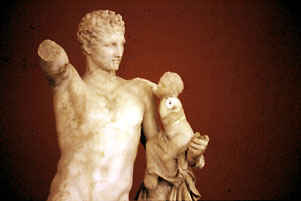
The site of Olympia, in a valley in the Peloponnesus, has been inhabited since prehistoric times. In the 10th century B.C., Olympia became a centre for the worship of Zeus. The Altis – the sanctuary to the gods – has one of the highest concentrations of masterpieces from the ancient Greek world. In addition to temples, there are the remains of all the sports structures erected for the Olympic Games, which were held in Olympia every four years beginning in 776 B.C.
The sanctuary of Olympia, in the North West of the Peloponnese, in the Regional Unit of Eleia (Elis), has been established in the valley created by the confluence of the Alpheios and Kladeos rivers in a natural setting of beauty and serenity. The Pan-Hellenic sanctuary has been established in the history of culture, as the most important religious, political and sports centre, with a history that dates back to the end of the Neolithic times (4th millennium BC). The famous sanctuary became the centre of worship of Zeus, the father of the twelve Olympian gods. For the Altis, the sacred grove and the centre of the sanctuary, some of the most remarkable works of art and technique have been created, constituting a milestone in the history of art. Great artists, such as Pheidias, have put their personal stamp of inspiration and creativity, offering unique artistic creations to the world. In this universal place, the Olympic Idea was born, making Olympia a unique universal symbol of peace and competition at the service of virtue. Here, too, prominence was given to the ideals of physical and mental harmony, of noble contest, of how to compete well, of the Sacred Truce; values, which remain unchanged in perpetuity.
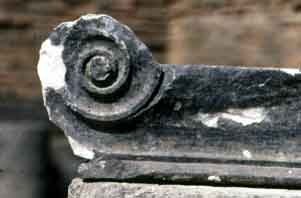
Ionian capital fragment in Olympia
photography: Francesco Saverio Alessio © copyright & all rights reserved 1998
The Ionic order was developed in the mid-6th century BCE by Ionian Greeks on the islands near present-day Turkey. By the 5th century BCE, it was popular in mainland Greece. The first time it was used on a major temple was for the Temple of Hera on Samos, built around 570 BCE by the Greek architect Rhoikos.
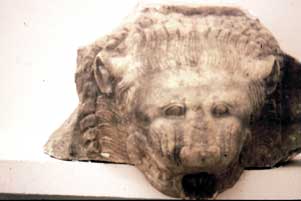
Lion's Head Waterspout
photography: Francesco Saverio Alessio © copyright & all rights reserved 1998
Olympia was the centre of worship of Zeus, the father of the twelve Olympian gods. Some of the most remarkable works of art were created to adorn Altis, the sacred grove and sanctuary. Great artists, such as Pheidias, put stamps of inspiration and creativity here, offering unique artistic creations to the world. Μany masterpieces have survived: large votive archaic bronzes, pedimental sculptures and metopes from the temple of Zeus, and the famous complex of Hermes by Praxiteles.
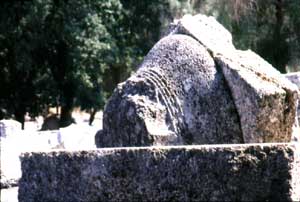
Doric capital fragment in Olympia
photography: Francesco Saverio Alessio © copyright & all rights reserved 1998
The Doric order is the earliest of the three Classical orders of architecture and represents an important moment in Mediterranean architecture when monumental construction made the transition from impermanent materials—like wood—to permanent materials, namely stone. The Doric order is characterized by a plain, unadorned column capital and a column that rests directly on the stylobate of the temple without a base.

Nike of Paionios
photography: Francesco Saverio Alessio © copyright & all rights reserved 1998
The Nike of Paionios is an ancient statue of the Greek goddess of victory, Nike, made by sculptor Paionios 425-420 BC. Made of Parian marble, the medium gives the statue a translucent and pure white look to it. Found in pieces, the statue was restored from many fragments but is lacking face, neck, forearms, part of left leg, toes, and some fragments of drapery. It also had wings. The goddess is shown landing gently on her left foot, with the drapery blown against her body.
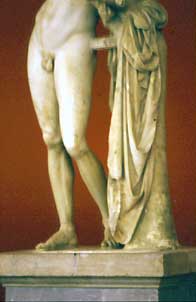
Hermes of Praxiteles
photography: Francesco Saverio Alessio © copyright & all rights reserved 1998
Hermes and the Infant Dionysus, also known as the Hermes of Praxiteles or the Hermes of Olympia is an ancient Greek sculpture of Hermes and the infant Dionysus discovered in 1877 in the ruins of the Temple of Hera, Olympia, in Greece. It is displayed at the Archaeological Museum of Olympia. It is traditionally attributed to Praxiteles and dated to the 4th century BC, based on a remark by the 2nd century Greek traveller Pausanias, and has made a major contribution to the definition of Praxitelean style. Its attribution is, however, the object of fierce controversy among art historians.

Nike of Paionios
photography: Francesco Saverio Alessio © copyright & all rights reserved 1998
Nike was by far the most common winged goddess portrayed in Classical art, and aside from her wings, her most consistently recognizable attribute- in both Athens and outside, seems to have been her flying drapery. This sculpture was designed to stand atop a column and be seen from below, as one would walk up along the path to the temple. Nike stands on a cloud of marble, furthering the idea that she is in the sky and among the clouds, coming down to Earth.
Links
This is a section of the site dedicated to the Mediterranean Architecture and that, going from the Mezquita de Cordoba to the Tiberius's Villa Iovis in Capri, from the Adalberto Libera's Villa Malaparte always in Capri until the Francesco Venezia's Gibellina Museum, from the Le Corbusier's Ronchamp Chapel to the Abbazia Florens of Gioacchino da Fiore and Luca Campano through the undergrounds of Naples, the underground architecture of the Greek Roman caverns exposed to the XVII Triennale of Milan, the ages, the cultural migrations, the Urbanism and Etno-Psychiatry, sometimes the losses, sometimes the contaminations, through various values and the religions, the aesthetic valences, with the contribution of personal written and of others Authors, of photography's, designs and other types of iconographic representations, 3d rendering, cad, videos, wants indicate a reflection course on this argument.